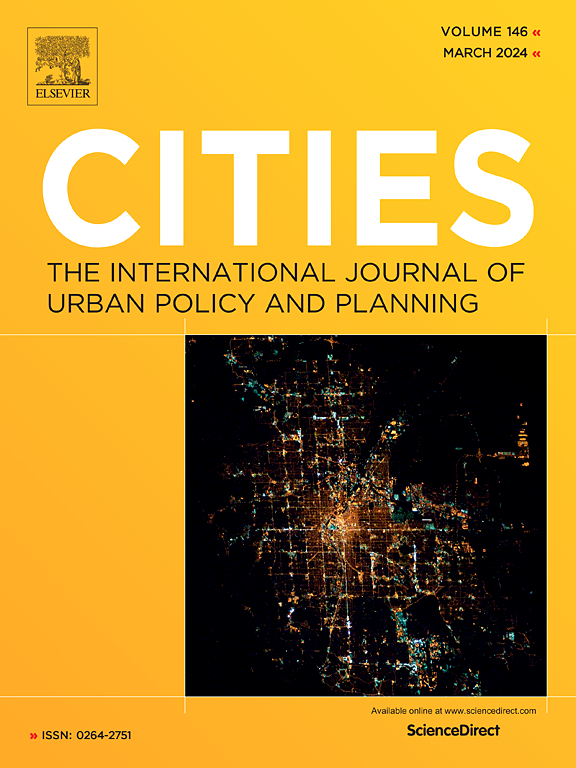酷热难耐探索高温对行人路线选择行为和可达性的影响
IF 6
1区 经济学
Q1 URBAN STUDIES
引用次数: 0
摘要
尽管许多城市都在鼓励采用非汽车交通方式来应对气候危机,但由于热浪的强度和频率不断上升,这些城市的可持续交通转型工作正面临挑战。在高温天,行人会面临很大的热压力,这可能会降低他们步行的意愿。因此,了解热量如何影响步行者的行为和可达性非常重要,这样才能使气候减缓战略更有针对性,不仅支持步行这种交通方式,也支持步行作为与公共交通的第一/最后一英里连接。在这项研究中,我们使用了马萨诸塞州波士顿市 2014 年夏季的行人出行数据集。除了几种路线属性(如长度、转弯、人行道宽度、便利设施、归一化差异植被指数和天空景观因子)外,我们还加入了热应力测量指标(通用热气候指数-UTCI),以解释行人的路线选择行为。通过使用路径大小逻辑回归模型,我们发现有证据表明,热压力对感知步行距离有相当大的影响,而且在统计学上有显著意义。我们还发现,这种影响是不均匀的,而且可能是指数影响。此外,我们还说明了热压力在多大程度上会降低行人到达重要目的地(如公共交通)的可达性。在典型的夏日,这种减少非常明显,而在最炎热的夏日,这种减少甚至更明显。据观察,与所有行人相比,非白人居民的可达性水平较低,这可能是由于城市热暴露的差异造成的。我们的研究结果凸显了将热暴露纳入交通规划和城市设计框架的重要性,尤其是以公平的视角来解决不平等的后果。本文章由计算机程序翻译,如有差异,请以英文原文为准。
Hot and bothered: Exploring the effect of heat on pedestrian route choice behavior and accessibility
Although many cities are incentivizing non-auto modes of transportation in response to the climate crisis, their sustainable mobility transition efforts are being challenged by the rising intensity and frequency of heatwaves. Pedestrians are exposed to high levels of heat stress on hot days, which may reduce their willingness to walk. It is thus important to understand how heat affects pedestrian behavior and accessibility, so that climate mitigation strategies can be better targeted to support walking as a mode of transport but also as a first-/last-mile connection to public transit. In this study, we used a dataset of pedestrian trips undertaken during the summer of 2014 in Boston, MA. Along with several route attributes (such as length, turns, sidewalk width, amenities, Normalized Difference Vegetation Index, and Sky View Factor), we also included a measure of heat stress (Universal Thermal Climate Index - UTCI) to explain pedestrian route choice behavior. Using path-size logistic regression models, we found evidence to suggest that heat stress has a considerable and statistically significant effect on the perceived walking distance. We also found that the effect was non-uniform and possibly exponential. Additionally, we illustrated the extent to which heat stress can reduce pedestrian accessibility to important destinations (such as public transit). This reduction was significant on a typical summer day, with an even sharper reduction on the hottest summer day. Non-White residents were observed to have lower accessibility levels compared to all pedestrians, likely because of disparities in urban heat exposure. Our findings highlight the importance of incorporating heat exposure into transportation planning and urban design frameworks, especially with an equity lens to address unequal consequences.
求助全文
通过发布文献求助,成功后即可免费获取论文全文。
去求助
来源期刊

Cities
URBAN STUDIES-
CiteScore
11.20
自引率
9.00%
发文量
517
期刊介绍:
Cities offers a comprehensive range of articles on all aspects of urban policy. It provides an international and interdisciplinary platform for the exchange of ideas and information between urban planners and policy makers from national and local government, non-government organizations, academia and consultancy. The primary aims of the journal are to analyse and assess past and present urban development and management as a reflection of effective, ineffective and non-existent planning policies; and the promotion of the implementation of appropriate urban policies in both the developed and the developing world.
 求助内容:
求助内容: 应助结果提醒方式:
应助结果提醒方式:


